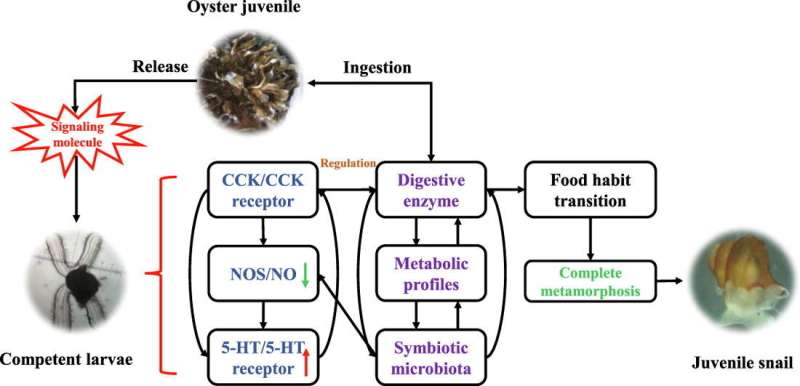How juvenile oysters affect metamorphosis of carnivorous gastropod Rapana venosa

Metamorphosis is required for most marine invertebrates to develop from larvae into adults. It is affected by abiotic factors such as temperature, salinity and illumination as well as biological factors such as food and microorganisms.
The veined rapa whelk (Rapana venosa) is a typical carnivorous gastropod. Previous studies found that juvenile oysters can act as inducers to improve the metamorphosis rate of Rapana venosa larvae. However, how the juvenile oysters affect the competent Rapana venosa larvae was unknown.
Recently, a research team led by Prof. Zhang Tao from the Institute of Oceanology of the Chinese Academy of Sciences (IOCAS) has evaluated the response of critical genes, symbiotic microbiome and metabolism profiles in competent larvae of R. venosa to the induction by juvenile oysters.
The study was published in Computational and Structural Biotechnology Journal.
The researchers found that under the induction of juvenile oyster, critical genes in the digestive system and neuroendocrine system were significantly altered in competent R. venosa larvae. The expression of the 5-hydroxytryptamine (5-HT) receptor was significantly increased, while the expression of the nitric oxide synthetase and cholecystokinin receptor was significantly decreased in juvenile oysters.
As a result of the induction and development of juvenile oysters, the symbiotic microbiota and host metabolic profiles showed marked changes. Differential microorganisms and metabolites were major enriched in the pathway of "arginine and proline metabolism," which is related to the biosynthesis of nitric oxide.
The researchers proposed a hypothetical model of juvenile oyster-induced metamorphosis in R. venosa. The compounds released by juvenile oysters likely interact with the larvae via taste or olfactory receptors, which triggers neuroendocrine system changes, including cholecystokinin and cholecystokinin receptor, 5-HT and 5-HT receptor, nitric oxide and nitric oxide synthetase.
Then, cholecystokinin may regulate the secretion of digestive enzymes and the development of the digestive system, thus initiating the food habit transition from herbivorous to carnivorous.
On the other hand, 5-HT and nitric oxide synthetase further regulate the metamorphosis of R. venosa, and symbiotic microbiota may also play an important role in affecting the food habit transition and metamorphosis.
More information: Mei-Jie Yang et al, Symbiotic microbiome and metabolism profiles reveal the effects of induction by oysters on the metamorphosis of the carnivorous gastropod Rapana venosa, Computational and Structural Biotechnology Journal (2021).
Journal information: Computational and Structural Biotechnology Journal
Provided by Chinese Academy of Sciences




















